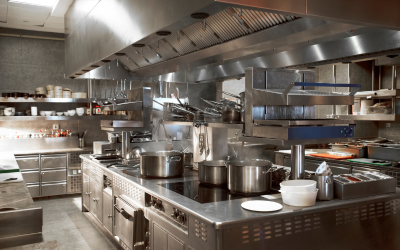A kitchen is the heart of every restaurant. It is a place where your menu comes to life. As a restaurant owner, you need to have high-quality equipment that can withstand the stresses of everyday use while sustaining the creation of delicious food. The equipment in the commercial
kitchen is equally important for the menu that will be served, along with the quality of the food, and the efficiency of the operations. While there are some kitchen equipment that can be taken for granted, there are certain tools and equipment that are very important to consider.
The tools and kitchen equipment that you invest in can make or break your business. Here is a list of the top essential kitchen tools and equipment that you need to succeed.
Understanding Restaurant Equipment
Two very critical components when designing a commercial kitchen space include – the supplier and the chef. It requires careful planning to maximize the efficiency as well as the functionality of the commercial kitchen. And your supplier is the key to supporting you with this process, helping you understand and prioritize the commercial catering equipment.
Must-Have Commercial Kitchen Equipment
Cooking Equipment
1. Ovens

Commercial ovens help in preparing a long list of menu items like fresh bread, buns, pastries, casseroles, and roasted meats. They provide high-capacity cooking, with different measures that suit your kitchen size and customer demand. Your menu and restaurant type can choose from different kinds of ovens, including:
- Convection ovens for cakes, cookies, and roasting
- Combination ovens to broil, steam, and roast.
- Pizza ovens.
- Conveyor ovens for consistent, quick-cooking items, such as toasted bagels and breakfast sandwiches.
2. Ranges and Ventilation
Ranges are perfect for creating all types of food pots, pans, and skillets, ranging from pasta to sauces and meat dishes. You can choose between gas or electric ranges, with gas ranges providing the live flame that is considered the gold standard for chefs.
3. Gas or Electric Grill

Whether you are looking to grill burgers, panini, or pancakes, your kitchen will need the perfect commercial grill. Restaurants that specialize in and serve all-day breakfasts or different sandwiches, can benefit a lot from the grill. However, grills require proper ventilation, and take up a lot of space, hence not all restaurants can accommodate an indoor grill.
Food Preparation Equipment
1. Food Processors
Commercial kitchens require handy food prep devices to support food preparation. Slicers and food processors help drastically reduce the preparation time.
2. Mixers

If your kitchen prepares a lot of baked goods, then a mixer is a must. The different options to choose from include-
- Hand mixers or blenders for sauces and soups.
- Countertop mixers for small batches of cookies, cakes, or bread batter.
- Floor mixers for larger batches of baked goods.
3. Slicers
Different from processors, slicers help with slicing meats and cheese. They can be commonly spotted in delis and sandwich shops. But for handcrafted charcuterie platters, you might require slicers.
4. Sharpening Stone
When investing a ton of money into your kitchen utensils and best knives, it is also important to ensure that their sharpening lasts for a longer time. To keep the knives in the right shape, invest in different sharpening stones. This will ensure that the prep staff always can chop, and prep with the best quality knives.
Cleaning Equipment
1. Washing Equipment
Washing equipment is essential in every restaurant kitchen. So make sure to have a good supply of mops, griddle brushes, absorbent hand towels, brooms, and commercial-grade cleaning solutions.
2. Storage Containers
Plastic liter containers and hotel pans of all shapes and sizes form the bedrock of every prep and line in every cooking operation. Due to this reason, you will need a lot of good containers. And don’t forget to keep a supply of Sharpies handy, as they will be a must for labeling the containers.
Kitchen Setup Equipment
1. Freezers and Refrigerators

Every commercial kitchen requires cold food storage. The type depends on the size and layout of the kitchen. You can opt to choose from reach-in or walk-in units. A hot climate requires high-quality refrigeration that can withstand heat and humidity. Plan to keep the unit outside or close to hot cooking equipment like ovens or stoves.
2. Storage Racks and Shelving
An option that can be often overlooked, it is important to choose a suitable shelving option that will help organize the kitchen and make it easier for the staff to operate.
3. Kitchen Display System (KDS)
Restaurants today use a kitchen display system (KDS) to keep their operations moving efficiently in the kitchen as well as throughout the restaurant. Mounted to the wall, kitchen display systems help the kitchen staff in viewing all open orders on a single screen. This makes it easier to keep the kitchens organized while fulfilling orders accurately and on time.
4. Sinks
Sinks play a significant role in commercial kitchens – from safety protocols such as washing hands and dishes to cleaning as well as preparing food. Different sinks in the restaurant include:
- Compartment sinks to rise, wash, and sanitize tools.
- Bar sinks to dump unfinished drinks and ice.
- Disposal sinks to dump and dispose of food scraps.
- Handwashing sinks to lower the risk of cross-contamination.
- Mop sinks for filling and emptying mop buckets.
The Importance of a Restaurant’s Point of Sale System
The point of sale, or POS system, is critical for a well-functioning restaurant. This system enables the waitstaff or front-of-house cashiers to document customers’ orders on a computer or tablet that can then be communicated with the KDS in the kitchen. The POS can be interfaced with a cash register as well as to track customers’ orders and check payments.
Considerations Before Purchasing Your Kitchen Tools and Equipment
When buying the right set of equipment for your restaurant kitchen, always look for high-quality items that will be able to stand constant use. Consider using restaurant financing to make the equipment purchase manageable. It is also important to ensure that the restaurant kitchen equipment items make sense in the kitchen layout you have a vision for. But, before diving into the list of your restaurant kitchen equipment, consider the following:
- Quality
- Pricing
- Space
- Ease in cleaning and use
- Choosing the right kitchen equipment supplier
- Hiring a planner
- Checking for a leasing option
Conclusion
Choosing the right equipment for your restaurant’s kitchen and the supplier goes a long way in ensuring that you are able to receive high-quality equipment. But now that you have a list of all the essential kitchen equipment, it’s time to sit down with the experts and work through a tailored blueprint that reflects all the unique circumstances. However, in the initial stages, it is equally important to have a planned budget. Your supplier should offer transparent and expert advice on what equipment is required. Trust them to build a bespoke list that includes all your preferences, timeframes, and costs.
We at TradeGully help you walk through our wide range of equipment selection and plenty of resources. Additionally, we also ensure that you are able to choose the right equipment for your restaurant.
FAQS
What are the 6 types of a commercial kitchen layout?
- Assembly Layout: Efficient for high-volume dish assembly.
- Island Layout: Central cooking station with surrounding areas.
- Zone Layout: Divides kitchen into task-specific zones.
- Galley Layout: Two parallel walls, ideal for limited space.
- Open Layout: Enhances visibility for open-concept eateries.
- Ergonomic Layout: Designed for staff comfort and productivity
What are the six kitchen equipment or tools?
Key kitchen equipment includes pots, pans, mixing bowls, spoons, knives, and graters. Additionally, conventional ovens are essential.
What are 4 simple machines in a kitchen?
Common simple machines in a kitchen include can openers (lever), pizza cutters (wheel and axle), vegetable peelers (wedge), and jar lids (screw). These gadgets ease our kitchen work.
What are 5 pieces of cooking equipment?
Five essential pieces of cooking equipment include a roasting pan for oven-cooked meats, a food processor for meal prep, a pie plate for baking, sheet pans for roasting or baking, and a cast-iron skillet.
What is food service equipment?
Food service equipment includes all tools and items essential for preparing, cooking, holding, and serving food in a commercial setting. It also covers washing equipment to ensure hygiene and cleanliness.






